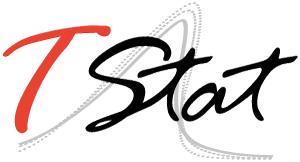LINEAR REGRESSION
- Influence statistics and fit diagnostics
- Ramsey regression specification-error test for omitted variables
- Variance-inflation factors
- Cook’s distance
- COVRATIO
- DFBETAs
- DFITs
- Diagonal elements of hat matrix
- Residuals, standardized residuals, studentized residuals
- Standard errors of the forecast, prediction, and residuals
- Welsch distance
- Constraints
- Instrumental variables
- Difference-in-differences estimation
- Heteroskedastic regression
- Truncated regression
- Errors in variables
- Multivariate regression
- Tests for heteroskedasticity
- Cook and Weisberg test
- Szroetzer’s rank test
- Information matrix test
- Cameron and Trivedi’s decomposition
- White’s test
- Tests for autocorrelation
- Durbin–Watson
- Durbin–Watson d statistic
- Breusch–Godfrey
- Tests for structural breaks
- Unknown break point
- Known break points
- Cumulative sum test for stability of coefficients
- ARCH LM test
- Moran’s test for spatial dependence
- Diagnostic plots
- Added variable (leverage) plot
- Component plus residual plot
- Leverage vs. squared residual plot
- Residual vs. fitted plot
- Residual vs. predictor
- Effect sizes
- Eta-squared—η 2
- Omega-squared—ω2
- Confidence intervals
- Fixed- and random-effects models for panel data
- Traditional, robust (Huber/White/sandwich), cluster–robust, bootstrap, or jackknife standard errors
- Multiway clustering
- HC2 with degrees-of-freedom adjustment
- Wildbootstrap confidence intervals and inference
- Robust regression
- Graph predictions and confidence intervals
- Newey–West estimator of variance
- Variance-weighted least squares
- GLM
- GLS for cross-sectional time-series data
- Multiple imputation
- Finite mixture models
- Bayesian estimation
- Linear regression with categorical predictors
- Linear regression with continuous predictors
- Linear regression with continuous and categorical predictors
- Video – Heteroskedastic linear regression
- Video – Tests for multiple breaks in time series
- Video – Simple linear regression
- Video – Instrumental-variables regression
- Video – A tour of effect sizes
- Video – New features in robust inference for linear models
- Video – Wild cluster bootstrap for linear regression
CENSORED OUTCOMES
- Interval censored (such as income reported in ranges)
- Tobit model
- Correlated data corrections to standard errors
- Heteroskedastic consistent standard errors
- Model heteroskedasticity
- Predictions
- Outcome in the absence of censoring
- Outcome conditional on being in the censoring interval
- Outcome with censoring imposed
- Probability of censoring
- Finite mixture models
- Bayesian estimation
- Interval regression with endogenous regressors, treatment effects, and sample selection
SAMPLE-SELECTION LINEAR MODELS
- Maximum likelihood and Heckman’s two-step estimation
- Robust, cluster–robust, bootstrap, and jackknife standard errors
- Linear constraints
- Combine with endogenous regressors and treatment effects
HURDLE MODELS
- Linear and exponential
- Lower or upper boundary values
- Robust, cluster—robust, bootstrap, and jackknife standard errors
STOCHASTIC FRONTIER MODELS
- Production and cost frontiers
- Half-normal, exponential, and truncated-normal distributions
- Modeling of conditional heteroskedasticity
QUANTILE REGRESSION
- Median regression
- Least absolute deviations (LAD)
- Regression of any quantile
- Interquantile range regression
- Standard errors
- Koenker and Bassett
- Robust — choose bandwidth and kernel
- Bootstrap
- Multiple imputation
FRACTIONAL POLYNOMIAL REGRESSION
- Support for a wide variety of models
- Component-plus-residual plots
- Support for zero-inflated regressors
© Copyright 1996–2025 StataCorp LLC. All rights reserved.
EXTENDED REGRESSION MODELS
- Combine endogeneity, Heckman-style selection, and treatment effects
- Linear regression
- Random effects in one or all equations
- Exogenous or endogenous regressors
- Exogenous or endogenous treatment assignment
- Binary treatment–untreated/treated
- Ordinal treatment levels–0 doses, 1 dose, 2 doses, etc.
- Endogenous selection using probit or tobit
- All standard postestimation command available, including predict and margins
LINEAR MIXED MODELS
- Multilevel random effects
- BLUP estimation
- Residual-error structures for linear models
- Standard errors of BLUPs
- Multiple imputation
- Bayesian estimation
ENDOGENEITY AND SIMULTANEOUS SYSTEMS
- Two-stage least-squares regression
- LIML estimation
- GMM estimation
- Instrumental variables
- Tests of instrumental relevance
- Tests of overidentifying restrictions
- Three-stage least-squares regression
- Linear constraints within and across equations
- Finite mixture models
- Linear regression with endogenous regressors, treatment effects, and sample selection
- Robust (Huber/White/sandwich) and cluster–robust standard errors
- Finite mixture models
INSTRUMENTAL-VARIABLES QUANTILE REGRESSIONS
- Inverse quantile regression estimator
- Smoothed estimating equations estimator
- Simultaneously estimate at different quantiles
- Hypothesis testing of endogenous effects
- Confidence intervals robust to weak instruments
SEEMINGLY UNRELATED REGRESSIONS
- Robust (Huber/White/sandwich) and cluster–robust standard errors New
- Linear constraints within and across equations
POSTESTIMATION SELECTOR
- View and run all postestimation features for your command
- Automatically updated as estimation commands are run
FACTOR VARIABLES
- Automatically create indicators based on categorical variables
- Form interactions among discrete and continuous variables
- Include polynomial terms
- Perform contrasts of categories/levels
MARGINAL ANALYSIS
- Estimated marginal means
- Marginal and partial effects
- Average marginal and partial effects
- Least-squares means
- Predictive margins
- Adjusted predictions, means, and effects
- Works with multiple outcomes simultaneously
- Contrasts of margins
- Pairwise comparisons of margins
- Profile plots
- Interaction plots
- Graphs of margins and marginal effects
- A single categorical variable
- A single continuous variable
- Interactions of categorical variables
- Interactions of categorical and continuous variables
- Interactions of two continuous variables
CONTRASTS
- Analysis of main effects, simple effects, interaction effects, partial interaction effects, and nested effects
- Comparisons against reference groups, of adjacent levels, or against the grand mean
- Orthogonal polynomials
- Helmert contrasts
- Custom contrasts
- ANOVA-style tests
- Contrasts of nonlinear responses
- Multiple-comparison adjustments
- Balanced and unbalanced data
- Contrasts in odds-ratio metric
- Contrasts of means, intercepts, and slopes
- Graphs of contrasts
PAIRWISE COMPARISONS
- Compare estimated means, intercepts, and slopes
- Compare marginal means, intercepts, and slopes
- Balanced and unbalanced data
- Nonlinear responses
- Multiple-comparison adjustments: Bonferroni, Šidák, Scheffé, Tukey HSD, Duncan, and Student–Newman–Keuls adjustments
- Group comparisons that are significant
- Graphs of pairwise comparisons

